American Artist: A Conceptual Reflection in Three Parts
Listen to this text
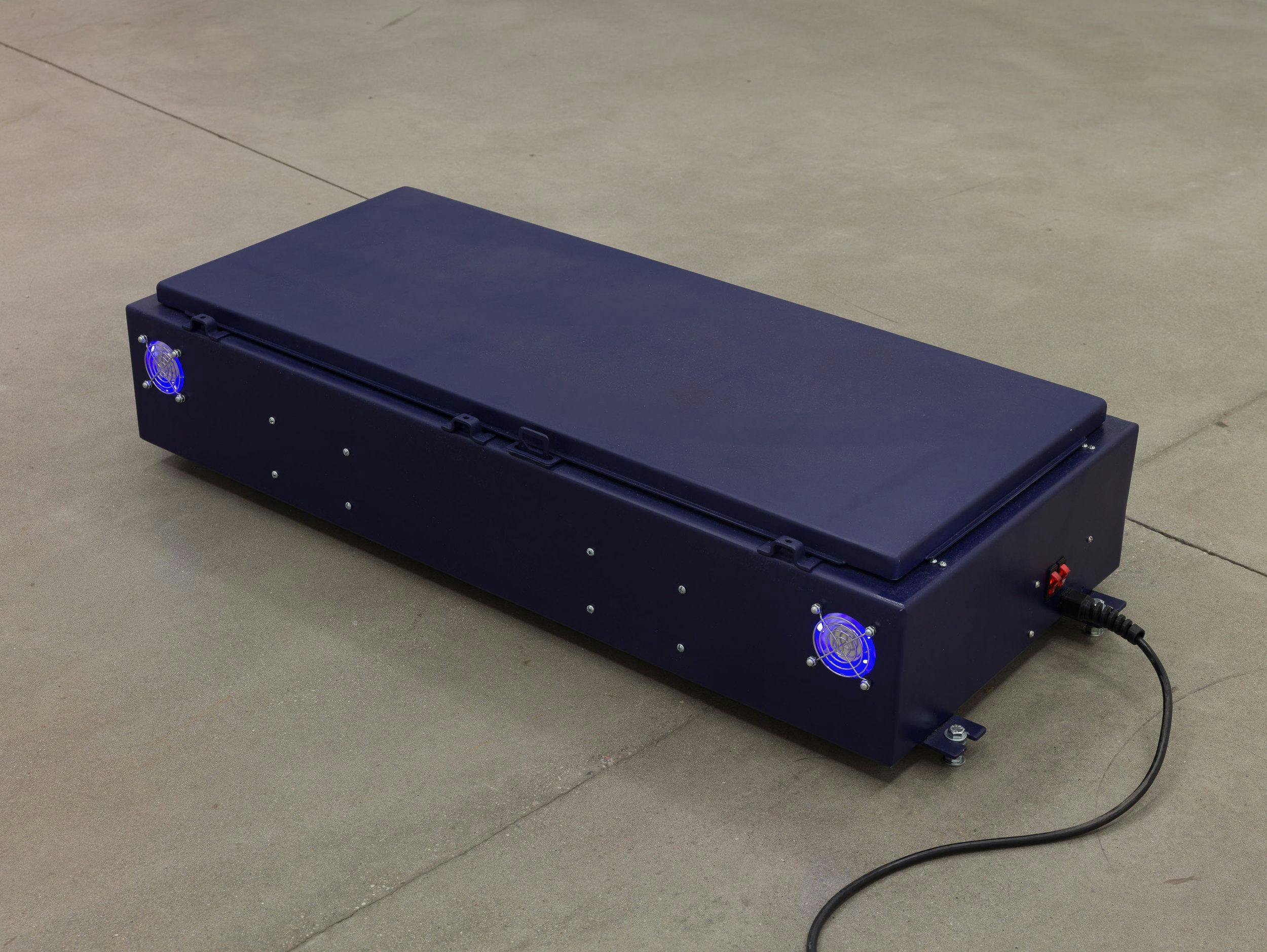
I.
My first in-person experience with American Artist’s work was at a 2019 installation of Dignity Images: Bayview-Hunters Point at the Museum of the African Diaspora in San Francisco. The smudged and cracked smartphone screens displayed portraits and snapshots of life from the titular economically deprived and isolated working-class neighborhood in southeastern San Francisco. It is, incidentally, the neighborhood with the city’s highest percentage of black Americans — almost a fifth of its black population.
In the Richard O. Moore documentary Take This Hammer, filmed in 1963 as San Francisco was becoming the epicenter of a radical countercultural movement, James Baldwin describes Bayview as “the San Francisco America pretends does not exist.” Against this backdrop of redlining, economic deprivation, and catastrophic environmental racism, Artist juxtaposes the visual “means by which Internet users may gain some measure of control over their increasingly mediated identities online,” toeing a fine line and “erecting boundaries between self-conception and assimilation to an avatar.”1 A teenager shows off the top of his head, his hair immaculately shaped and set into waves; a young boy playfully poses with an adoring grandmother; a bespectacled adolescent appears in a hooded sweatshirt, his mostly obscured face backed by a brilliantly blue, clouded sky; an elderly uncle takes a charmingly amusing, far-too-close selfie.
Contrary to the seemingly self-evident language of the name, the dignity image does not simply intend to disrupt negative stereotypes of black people, as the Twitter hashtag #NoAngel sought to counter The New York Times’s racist characterization of Michael Brown by insisting on the imperfection of living black people and black victims alike. Rather, the genre that Artist coined seeks to unsettle a digital economy of surveillance and commodification by exhibiting, outside of social media, photographs that would otherwise become habituated within an exponentially expanding, constantly mined data pool of algorithm-driven and essentialized blackness™.
Rob Horning describes the compulsion to digitally reproduce oneself as “autocannibalism”; refusing this trap allows for the possibility of exiting the “hermetic feedback loop” of self-surveillance, a self-conception that forecloses new imaginaries of oneself and others (as well as the interplay of oneself in relation to others).2 Changing one’s name to American Artist, as the artist did in 2013, is another performance of this praxis, a gesturing toward simultaneous anonymity and ubiquity in considering potentialities for the existence of blackness in public.
This seeing and unseeing/refusing to be seen has long been spatialized. In their 2021 work Veillance Caliper (Annotated), Artist assembles the skeleton of a giant three-dimensional, boxlike structure whose central axes measure “sous-” and “sur”-veillance in positive (seeing or being seen) and negative (not seeing or being unseen) directions. (Sousveillance, as defined by wearable computer inventor Steve Mann, is an inverse surveillance via self-affixed or worn device.)3 Through this multidirectionality and simultaneity of watching and being watched, Artist places anti-black surveillance and sousveillance against Simone Browne’s impossible-to-account-for dark sousveillance, a practice she describes as the “freedom practices to evade surveillance.”4 This struggle for the inalienable right to (an informatic) opacity against “the growing popularity of the Quantified Self”5 is the nucleus of Artist’s practice.
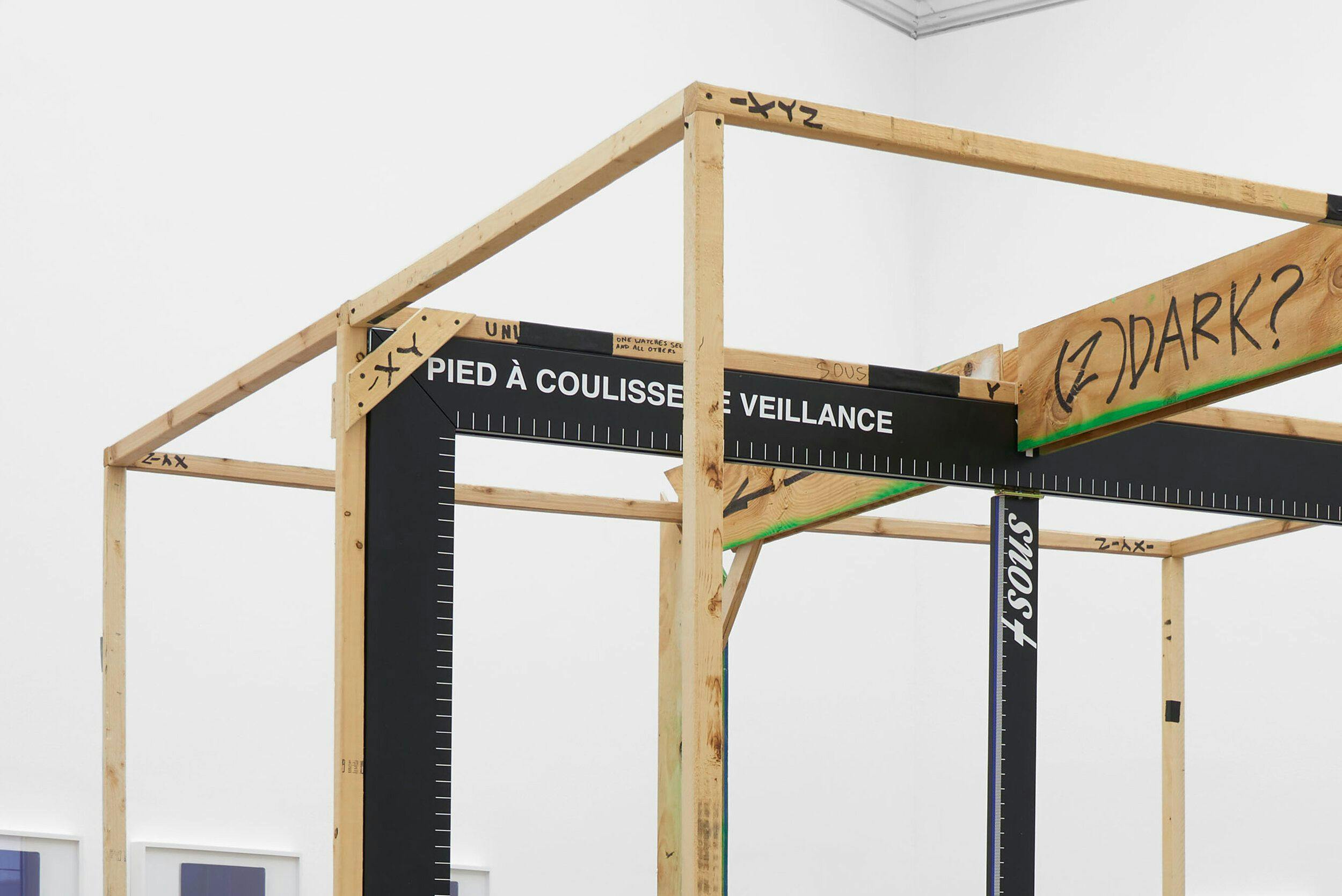
II.
According to cybernetics and ethnomathematics scholar Ron Eglash, the earliest U.S. patent to employ the master-slave metaphor is No. 2510461: a “Multistation Microwave Communication System” from 1946. Hegel’s master-slave dialectic has always found comfortable usage in technology; it’s a linguistic construction that logically follows the centuries of expropriated black labor that have animated all productions of Euromodern technology. The metaphor, after all, describes the asymmetric mode of communication in which a master device controls one or more slave devices or processes.
Artist’s Black Gooey Universe series, whose title plays on the phonetic pronunciation of graphic user interface (GUI), examines this enduring labor relation so often eclipsed by the glitzy, technocratic libertarian allure of Silicon Valley. Mother of All Demos II (2021) is a blocky vintage Apple desktop computer whose keyboard is marred by an oil-like substance stuck in a suspended drip from the displaying table-pedestal. Two black handprints frame the puddle, as though the user dipped her hands in the staining muck before slamming them on the table. Prior to the introduction of the GUI, monitors had black screens; with the advent of Apple Lisa 1983, Artist writes, users had the “ability to point and click on ‘folders’ and ‘windows’ in white space reminiscent of blank paper sheets.” This chromatic transition, Artist writes in their 2018 essay “Black Gooey Universe” in the journal unbag, was an example of “a white ideological mechanism created with the intent of universal application.”
Artist is rightfully emphatic in articulating that the stakes of technological production are black life itself, from the chattel slavery system that made possible the First Industrial Revolution to the Big Four conflict minerals (tungsten, tantalum, tin, and gold) essential to consumer electronics and mined in precarious conditions in Central Africa. The first iteration of No State during Artist’s 2018 exhibition at HOUSING in Brooklyn illustrates these stakes. A funereal 12x12 floor arrangement of black iPhones in various states of disrepair recalls both the harrowing iconicity of the eighteenth-century slave ship Brookes and the anonymous black dead of our current age (whether African migrants crossing the Mediterranean or the mass burials of people killed in the ongoing conflicts in the Democratic Republic of Congo). Under the transnational specter of antiblack social death (a condition in which people — here, black people — are neither understood by nor accepted within society as fully human), the title makes reference to the exploitation ongoing even on the “post”-colonial African continent.
Artist offers a prescient warning for the artificial intelligence “revolution”: Its displacement of human workers fails to unsettle and, in fact, reiterates the racial labor relation. AI is a robot; the robot is a slave.
Czech writer Karel Čapek is credited with introducing and popularizing the word “robot,” which was central to his 1920 science-fiction play R.U.R. (Rossum’s Universal Robots). “Robot” is derived from the Czech word “robota,” which refers to forced labor. “The best sort of worker is the cheapest worker,” declares one of the play’s main characters, the Director General of Rossum’s Universal Robots. And the cheapest worker, of course, is “one that has the least needs,” one with the fewest human impulses, one whose automated processes can be programmed, bred and rebred, or cloned. The best worker, this soulless, mechanized laborer, is essentially enslaved. It does not “cling to life,” nor does it have a “sense of pleasure.” Yet from the inception of the genre, the robot always revolts; or, as in Alexandr Andriyevksy’s Soviet filmic analogue in the 1935 Loss of Sensation, it is weaponized. And there is no robot revolt — no slave revolt — that does not necessitate some destruction of Man, because it is humanity itself that makes possible the conditions of bondage and servitude.
Artist sets a stage for this antagonism.
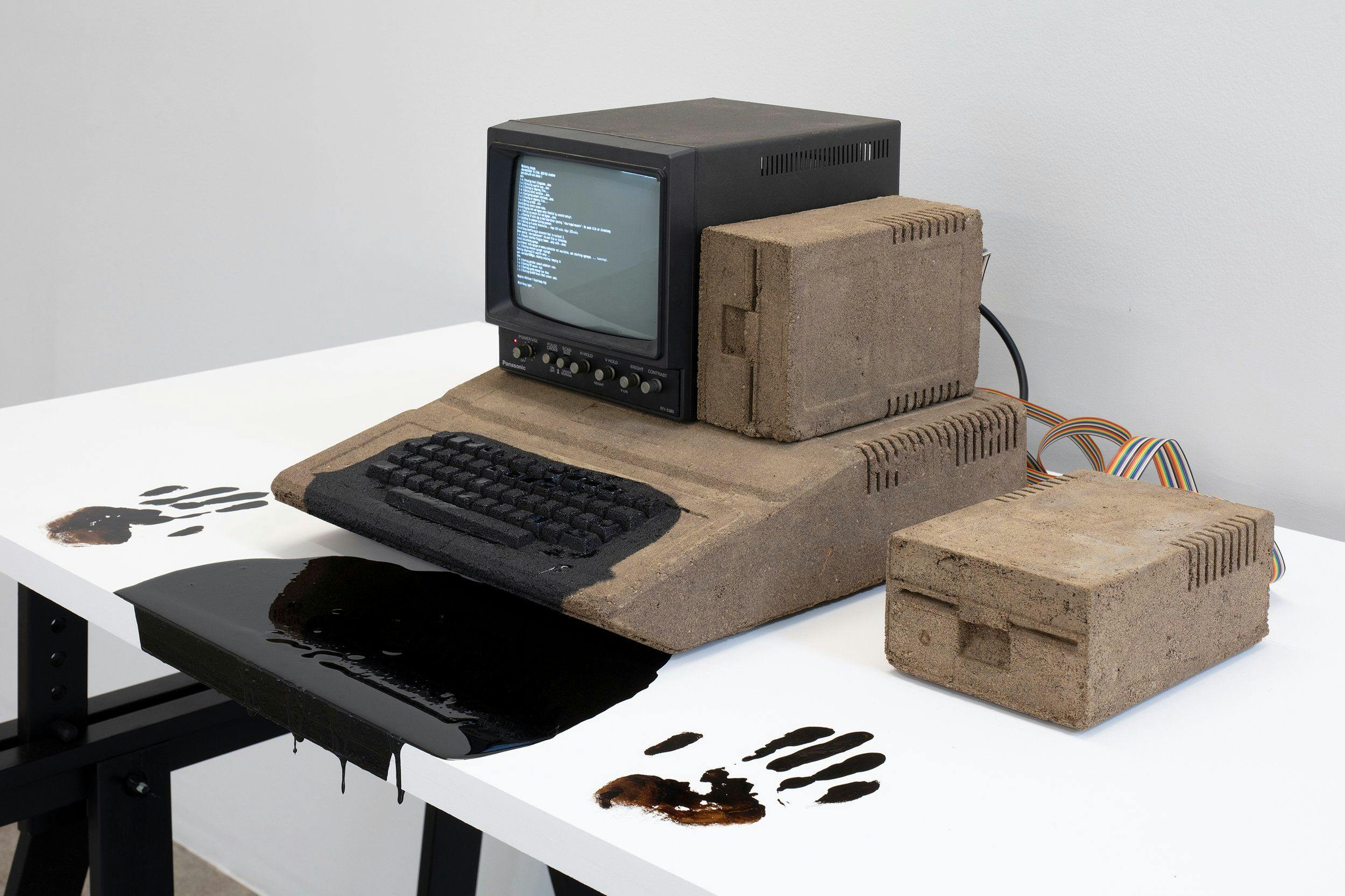
III.
The gooey black-to-white transition is necessarily a chromophobic one: It occurred within a regime of color that not only privileges whiteness, but preoccupies itself with the management of all (other) colors. David Batchelor writes about a white that is not only the absence, but also the absenting of color: a white that’s whiter than white, a white that marshals and bleaches, a white(ness) whose entire existence comprises materialized delusion through negative hallucination and refusal to properly perceive and acknowledge the quality of color that actually exists.
Responding in “Black Gooey Universe” to their own question of what black is as “counterpuntal and primordial” to the screen’s refined whiteness, Artist offers a definition as both an amalgam of color and light and a lightless void that permits sight. Via black studies theorist Jared Sexton, whose thinking Artist builds on, this paranoid chromophobic regime understands that “everything is (always and already) black, all black, inescapably black, despite its best attempts at distancing.”
Artist’s image What is the Being of a Problem? (2018) mirrors W.E.B. Du Bois’s foundational 1903 provocation: “Between me and the other world there is ever an unasked question […] To the real question, How does it feel to be a problem? I answer seldom a word.”
Blackness is a void, is devoid of human life. A photograph of the corner of a blackened computer is punctuated by coated streaks we might imagine to be Vantablack, the commercialized superblack marketed as the blackest black and sold to both aerospace and military sectors from 2014. If the approximate opposite of white is black, the opposite of black life is blue life.
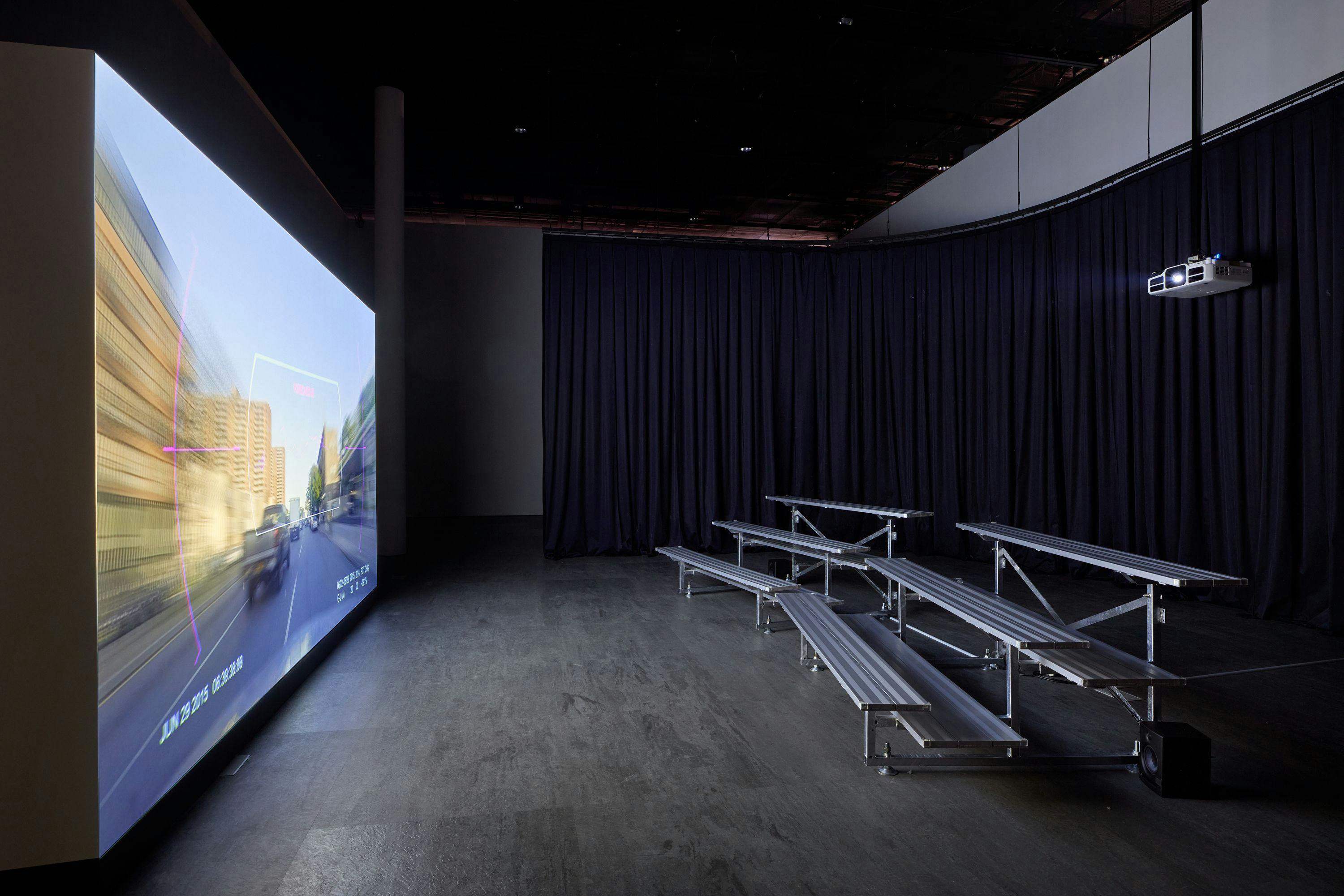
As Nijah Cunningham and Tiana Reid state in their 2018 essay “Blue Life,” the response to the Black Lives Matter movement through the state’s legislative and epistemic sorcery “summons the [black] specter of the enemy that it seeks to annihilate” in order to ultimately “strengthen the fiction that the law is just.” Artist’s 2019 installation I’m Blue (If I Was █████ I Would Die) intimates color in its titular redaction: It’s a play on a popular misarticulation of the choral refrain of Eiffel 65’s “Blue (Da Ba Dee)” and also an allusion to this violent chromatic ordering of blueness and blue life as whiteness.
The room’s arrangement mimics a police academy space, where the cadet students ostensibly sit at one of the six almost typical classroom desks, affixed with ballistic shields and coated (swaddled) in law enforcement navy blue. The desks form a barricade for the trainee riot police being schooled in their counterinsurgency pose, preparing for the inevitable and always existent domestic threat. On a television screen is Blue Life Seminar, whose speaker-instructor is a luminous blue figure: a hybridization of Watchmen character Doctor Manhattan, recognizable by the atomic structure for hydrogen on his forehead, and the likeness of Christopher Dorner, a different kind of killer cop. The shared disillusionment of the two figures produces opposite consequences, though it is unclear where the borders of each one’s inner monologues begin and end in the video’s audio. Doctor Manhattan takes self-exilic flight to Mars to prevent himself from being weaponized by the U.S. Department of Defense; Dorner began targeting police officers in 2013 after a failed legal attempt to gain a public admission by the Los Angeles Police Department that he was fired in retaliation for his attempt to report misconduct and excessive force in the department.
Blue Life Seminar finds chromatic dialogue with My Blue Window, an unsettling immersion into the operation of predictive policing that we understand in its aggregate, but not necessarily in its quotidian function. 2015, 2019 reveals the semi-mysterious calculations of this algorithmic policing: a mapping of the area’s geography, a navigation through a visibly poorer and less developed area of the municipality, the computational tabulation of crimes seemingly calculated out of nowhere, and the occasional targeted registering of black bystanders and pedestrians. Technological surrealism means this blue window, an analogous blue screen of death, is gamified: “crime deterred[!]” flashes victoriously, although you don’t necessarily realize when or where or how. But the omnipresent threat of blackness to blue life always demands policing, Artist’s work chillingly insists — there is no other organizing logic to it.
Footnotes
- 1
American Artist, “A Declaration of the Dignity Image,” The New Inquiry, 2016. Link.
- 2
Rob Horning, “Reacting to Reactions,” The New Inquiry, 2016. Link
- 3
Steve Mann, Jason Nolan, and Barry Wellman, “Sousveillance: Inventing and Using Wearable Computing Devices for Data Collection in Surveillance Environments,” Surveillance & Society 1, no. 3 (2003): 331–355.
- 4
Simone Browne, Dark Matters: On the Surveillance of Blackness (Durham: Duke University Press, 2015).
- 5
Zach Blas, “Informatic Opacity,” in Posthuman Glossary, eds. Rosi Braidotti and Maria Hlavajova (London: Bloomsbury Academic, 2018), 198–199.
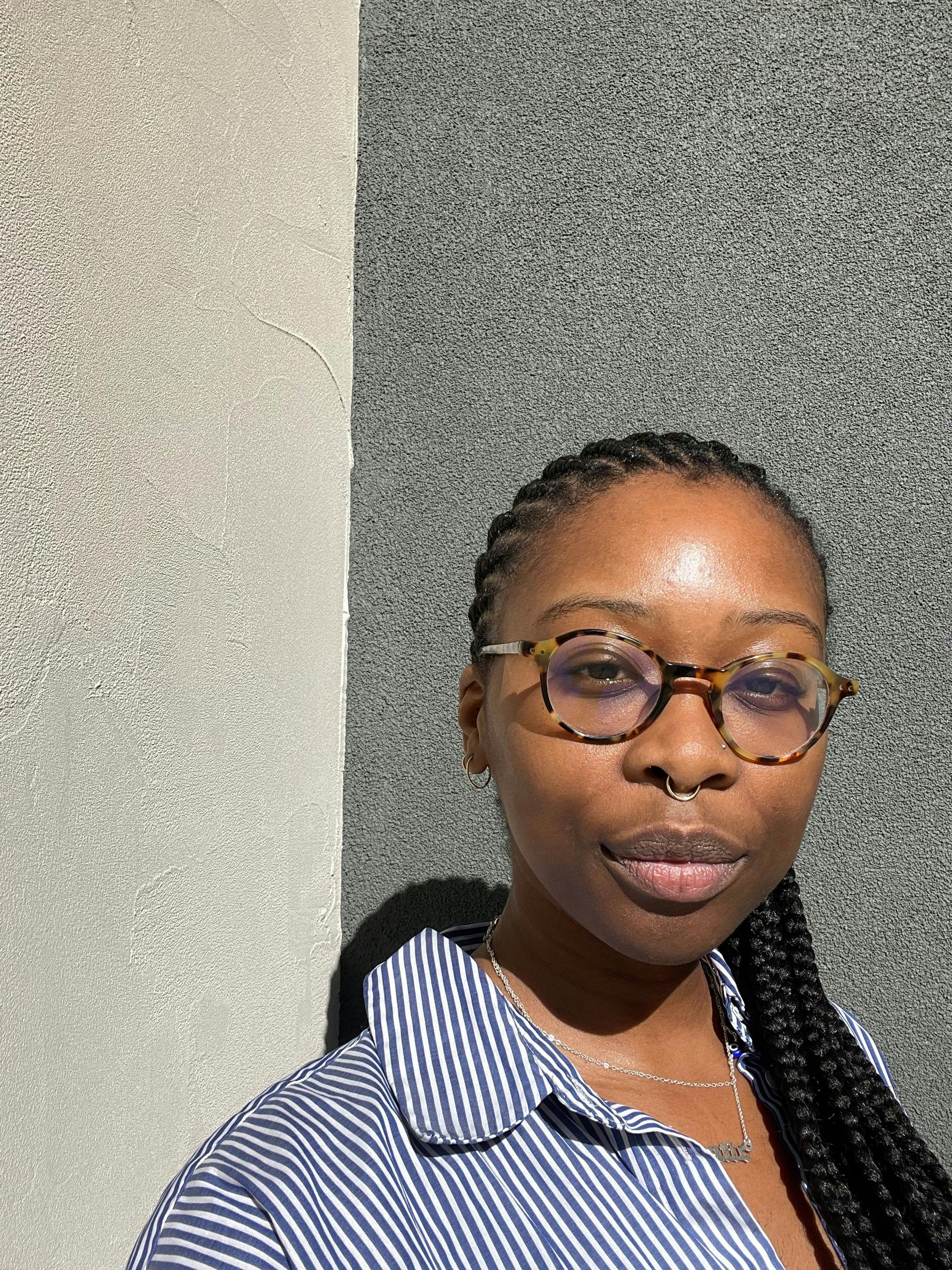
Zoé Samudzi is an Assistant Professor in Photography at the Rhode Island School of Design. Samudzi is an Associate Editor with Parapraxis Magazine and a writer and critic, whose work has appeared in Artforum, Bookforum, The New Republic, Art in America, The New Inquiry, The Funambulist, The Architectural Review, and SSENSE.
Website
zoesamudzi.com
Instagram
@babywasu
Twitter
@ztsamudzi
Photo by Zoé Samudzi
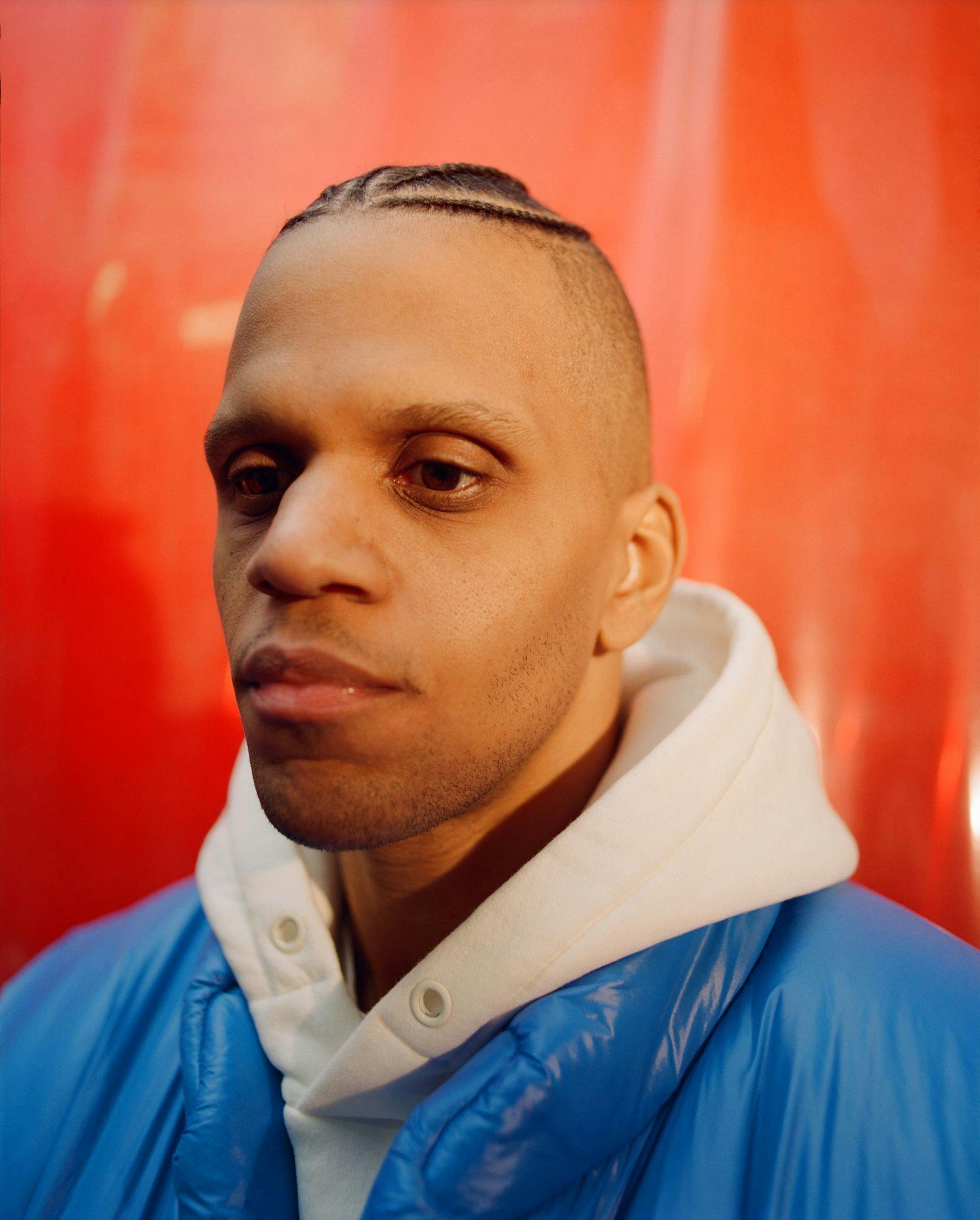
American Artist makes thought experiments that mine the history of technology, race, and knowledge production, beginning with their legal name change in 2013. Artist's artwork primarily takes the form of sculpture, software, and video. They are a 2022 Creative Capital and United States Artists Fellow, and a 2021 LACMA Art & Tech Lab Grantee. They are a former resident of Smack Mellon, Red Bull Arts Detroit, Abrons Art Center, Recess, Eyebeam, Pioneer Works, and the Whitney Museum Independent Study Program. They have exhibited at the Whitney Museum of American Art; MoMA PS1; Studio Museum in Harlem; Museum of Contemporary Art Chicago; Kunsthalle Basel, Switzerland; and Nam June Paik Center, Seoul. Their work has been featured in The New York Times, Cultured, Artforum, and Art in America. Artist is a co-director of the School for Poetic Computation and a full-time faculty at Yale.
Website
americanartist.us
Instagram
@a_____rtist
Twitter
@a_____rtist
Photo by Myles Loftin